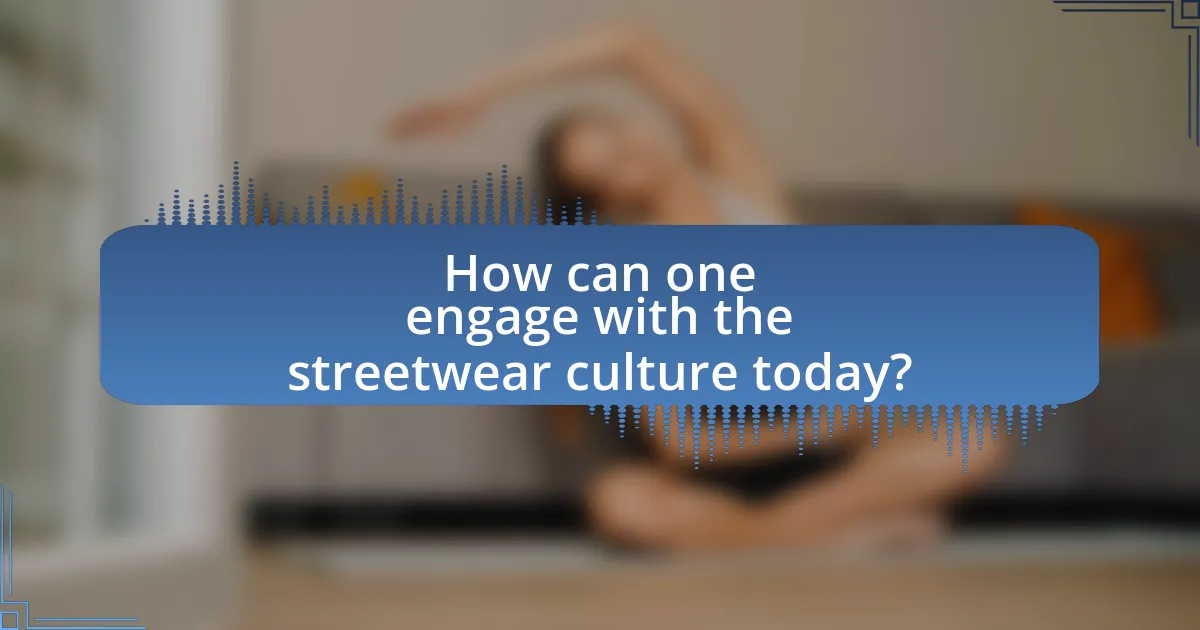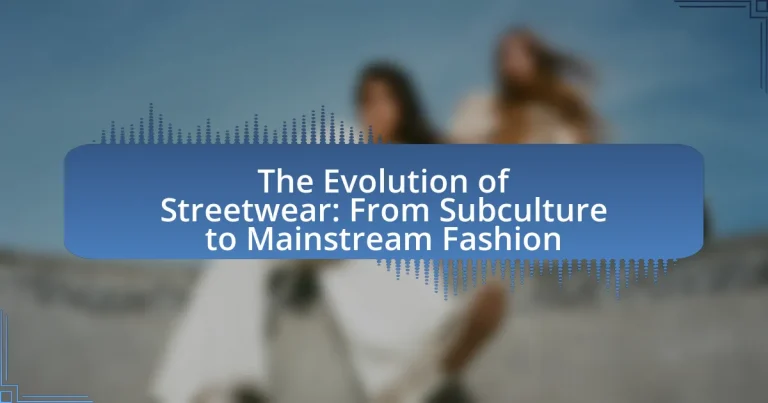The article examines the evolution of streetwear, tracing its origins from late 1970s skate and hip-hop cultures to its current status as a dominant force in mainstream fashion. It highlights key milestones, including the emergence of influential brands like Stüssy and Supreme, and the impact of collaborations with high fashion designers. The article also discusses the defining characteristics of streetwear, the role of graphic design, and the influence of social media and celebrity endorsements in its rise. Additionally, it explores current trends, sustainability practices, and ways individuals can engage with the streetwear community.

What is the Evolution of Streetwear?
The evolution of streetwear began in the late 1970s and early 1980s, originating from skate and hip-hop cultures in urban environments. Initially, brands like Stüssy and Supreme emerged, focusing on casual, comfortable clothing that reflected the lifestyle and attitudes of youth subcultures. By the 1990s, streetwear gained traction as it incorporated elements from high fashion, with designers like Jean-Paul Gaultier and Comme des Garçons collaborating with street brands, thus bridging the gap between luxury and casual wear. The 2000s saw streetwear become a global phenomenon, with brands like Off-White and A Bathing Ape achieving significant commercial success and cultural influence. Today, streetwear is a dominant force in the fashion industry, characterized by its blend of art, music, and social commentary, and is embraced by mainstream retailers and luxury brands alike, illustrating its transition from niche subculture to a widely recognized fashion category.
How did streetwear originate as a subculture?
Streetwear originated as a subculture in the late 1970s and early 1980s, primarily influenced by skateboarding, hip-hop, and punk cultures. This emergence was characterized by a blend of casual clothing, graphic tees, and sneakers, reflecting the lifestyles and attitudes of urban youth. The rise of brands like Stüssy and Supreme, which incorporated elements of street art and music, solidified streetwear’s identity. By the 1990s, streetwear had gained traction through collaborations with artists and musicians, further embedding it into popular culture and establishing its significance as a distinct subculture.
What cultural influences shaped the early streetwear movement?
The early streetwear movement was shaped by a combination of skate culture, hip-hop music, and graffiti art. Skate culture introduced a casual, rebellious aesthetic that emphasized comfort and individuality, while hip-hop music brought a sense of urban identity and self-expression, influencing fashion choices with oversized clothing and bold graphics. Graffiti art contributed visual elements that were often incorporated into clothing designs, reflecting the raw, artistic spirit of the streets. These cultural influences collectively established streetwear as a distinct style that resonated with youth subcultures in urban environments during the late 1970s and 1980s.
Who were the key figures in the development of streetwear?
The key figures in the development of streetwear include Shawn Stussy, Hiroshi Fujiwara, and Nigo. Shawn Stussy, the founder of Stüssy, is often credited with popularizing streetwear in the 1980s by blending surf culture with urban fashion. Hiroshi Fujiwara, known as the “Godfather of Streetwear,” played a crucial role in shaping the genre through his brand, Fragment Design, and collaborations with major labels. Nigo, the creator of A Bathing Ape (BAPE), further propelled streetwear into mainstream fashion in the 1990s with his unique designs and marketing strategies. These individuals significantly influenced the aesthetics and cultural relevance of streetwear, establishing it as a dominant force in contemporary fashion.
What are the defining characteristics of streetwear?
Streetwear is characterized by its casual, urban style that blends elements of hip-hop, skate culture, and high fashion. This fashion genre often features oversized silhouettes, graphic tees, hoodies, and sneakers, emphasizing comfort and self-expression. The use of bold logos and unique designs is prevalent, often reflecting social and political themes. Streetwear’s roots in subcultures, particularly in the 1980s and 1990s, contribute to its distinct identity, with brands like Supreme and Off-White exemplifying its evolution into mainstream fashion. The cultural significance of streetwear is underscored by its influence on global fashion trends and collaborations with luxury brands, showcasing its transition from niche to widely accepted style.
How does streetwear differ from traditional fashion styles?
Streetwear differs from traditional fashion styles primarily in its emphasis on casual, urban aesthetics and cultural influences rather than formal design and high fashion. Traditional fashion often prioritizes craftsmanship, seasonal trends, and designer labels, while streetwear focuses on comfort, self-expression, and accessibility, often drawing inspiration from youth culture, music, and art. For example, brands like Supreme and Off-White have gained popularity by merging graphic designs with everyday wear, contrasting with the structured silhouettes and luxury materials typically found in traditional fashion. This shift reflects a broader cultural movement where streetwear has become a significant influence in mainstream fashion, as evidenced by collaborations between streetwear brands and high-end designers, showcasing its impact on contemporary style.
What role does graphic design play in streetwear aesthetics?
Graphic design is integral to streetwear aesthetics as it serves as a visual language that communicates identity, culture, and social commentary. The use of bold graphics, typography, and imagery in streetwear not only enhances the visual appeal of clothing but also reflects the subcultural roots and influences of the genre, such as skateboarding, hip-hop, and graffiti art. For instance, brands like Supreme and Off-White utilize distinctive graphic elements to create a sense of exclusivity and community among their consumers, reinforcing brand loyalty and cultural relevance. This relationship between graphic design and streetwear aesthetics is evidenced by the significant impact of graphic-heavy collections on sales and brand recognition, illustrating how effective design can elevate a brand’s status within the fashion industry.
Why did streetwear transition to mainstream fashion?
Streetwear transitioned to mainstream fashion due to its cultural relevance and the influence of celebrities and social media. The rise of hip-hop culture in the 1980s and 1990s established streetwear as a significant style, which was further amplified by endorsements from high-profile figures like Kanye West and Rihanna. Additionally, the proliferation of social media platforms allowed brands to reach wider audiences, making streetwear accessible and desirable. This shift is evidenced by collaborations between streetwear brands and luxury fashion houses, such as Louis Vuitton’s partnership with Off-White, which solidified streetwear’s place in high fashion.
What societal changes contributed to the rise of streetwear in mainstream culture?
The rise of streetwear in mainstream culture was significantly influenced by the democratization of fashion, the rise of youth culture, and the impact of social media. The democratization of fashion allowed for a blending of high fashion and casual wear, making streetwear accessible to a broader audience. Youth culture, particularly in urban areas, embraced streetwear as a form of self-expression and identity, leading to its popularity among younger demographics. Additionally, social media platforms like Instagram and TikTok facilitated the rapid spread of streetwear trends, enabling brands and influencers to reach global audiences quickly. These societal changes collectively transformed streetwear from a niche subculture into a dominant force in mainstream fashion.
How did collaborations between streetwear brands and high fashion influence this transition?
Collaborations between streetwear brands and high fashion significantly accelerated the transition of streetwear into mainstream fashion. These partnerships, such as those between Supreme and Louis Vuitton, introduced streetwear aesthetics to luxury markets, validating streetwear as a legitimate fashion category. The collaboration between Off-White and Nike further exemplified this trend, merging high fashion design principles with athletic wear, which attracted a broader audience and increased demand. As a result, high fashion brands began to incorporate streetwear elements into their collections, leading to a cultural shift where streetwear became synonymous with luxury, ultimately reshaping consumer perceptions and market dynamics in the fashion industry.

What are the key milestones in the evolution of streetwear?
The key milestones in the evolution of streetwear include the emergence of skate culture in the late 1970s, the influence of hip-hop in the 1980s, the establishment of brands like Stüssy and Supreme in the 1990s, and the mainstream acceptance of streetwear in the 2000s and 2010s. Skate culture, characterized by its casual and rebellious style, laid the foundation for streetwear, while hip-hop introduced graphic tees and oversized silhouettes. Stüssy, founded in 1980, is often credited with popularizing streetwear as a distinct fashion category, followed by Supreme’s launch in 1994, which became a cultural phenomenon. The 2000s saw collaborations between high fashion and streetwear brands, solidifying streetwear’s place in mainstream fashion, as evidenced by luxury brands like Louis Vuitton partnering with streetwear designers.
How did the 1990s influence streetwear’s growth?
The 1990s significantly influenced streetwear’s growth by merging urban culture with high fashion, leading to its mainstream acceptance. This decade saw the rise of influential brands like Stüssy and Supreme, which catered to youth culture and skateboarding communities. Additionally, the popularity of hip-hop music and its associated fashion trends, exemplified by artists like A Tribe Called Quest and Wu-Tang Clan, propelled streetwear into the spotlight. The emergence of sneaker culture, highlighted by collaborations between brands like Nike and designers, further solidified streetwear’s status. By the end of the 1990s, streetwear had transitioned from a niche subculture to a recognized segment of the fashion industry, evidenced by its presence in major retail outlets and fashion shows.
What brands emerged during the 1990s that defined the streetwear landscape?
Brands that emerged during the 1990s that defined the streetwear landscape include Supreme, Stüssy, and A Bathing Ape (BAPE). Supreme, founded in 1994, became iconic for its box logo and collaborations, influencing skate culture and fashion. Stüssy, established in the early 1980s but gaining prominence in the 1990s, blended surf and skate aesthetics, becoming a cornerstone of streetwear. A Bathing Ape, launched in 1993, introduced unique designs and the popular ape logo, significantly impacting the global streetwear scene. These brands collectively shaped the identity and evolution of streetwear during that decade.
How did hip-hop culture impact streetwear in the 1990s?
Hip-hop culture significantly influenced streetwear in the 1990s by popularizing styles that emphasized individuality and self-expression. Artists like Tupac Shakur and Notorious B.I.G. showcased oversized clothing, graphic tees, and athletic wear, which became staples in street fashion. The rise of brands such as FUBU and Phat Farm, founded by hip-hop figures, further solidified this connection, as they catered directly to the hip-hop audience and reflected its values. Additionally, the integration of hip-hop aesthetics into mainstream fashion was evident through collaborations with high-profile designers and the visibility of hip-hop artists in fashion campaigns, which helped bridge the gap between subculture and mainstream appeal.
What role did social media play in the evolution of streetwear?
Social media significantly accelerated the evolution of streetwear by providing a platform for brands and influencers to reach a global audience. This digital landscape allowed streetwear brands to showcase their designs, engage with consumers, and cultivate a community around their products. For instance, platforms like Instagram and TikTok enabled brands such as Supreme and Off-White to gain massive followings and create hype around limited releases, leading to increased demand and sales. Additionally, user-generated content and influencer marketing on these platforms have played a crucial role in shaping trends and driving the popularity of streetwear, transforming it from a niche subculture into a dominant force in mainstream fashion.
How has Instagram changed the way streetwear is marketed and consumed?
Instagram has transformed streetwear marketing and consumption by enabling brands to reach wider audiences through visual storytelling and influencer partnerships. The platform’s emphasis on imagery allows streetwear brands to showcase their products in dynamic and engaging ways, leading to increased brand visibility. Influencers, who often have large followings, play a crucial role in this ecosystem by promoting streetwear items, which can drive consumer interest and sales. According to a 2021 study by Business of Fashion, 70% of consumers reported that social media influences their purchasing decisions, highlighting Instagram’s significant impact on consumer behavior in the streetwear market.
What impact do influencers have on streetwear trends today?
Influencers significantly shape streetwear trends today by leveraging their social media platforms to promote brands and styles. Their ability to reach large audiences allows them to introduce and popularize specific clothing items, collaborations, and aesthetics, often leading to viral trends. For instance, collaborations between influencers and streetwear brands, such as the partnership between fashion influencer Aimee Song and the brand Revolve, have resulted in increased visibility and sales for those brands. Additionally, influencers often set the tone for what is considered fashionable, as seen in the rise of oversized silhouettes and bold graphics, which they frequently showcase in their content. This direct engagement with their followers creates a feedback loop, where trends can rapidly evolve based on influencer endorsements and audience reactions.
What are the current trends in streetwear fashion?
Current trends in streetwear fashion include oversized silhouettes, bold graphics, and a blend of high-end and casual styles. Oversized clothing, such as baggy jeans and large hoodies, has gained popularity, reflecting a comfort-driven aesthetic. Bold graphics and logos are prevalent, often featuring collaborations with artists and brands, which enhance the uniqueness of pieces. Additionally, the fusion of luxury fashion with streetwear, exemplified by brands like Off-White and Balenciaga, showcases the mainstream acceptance of streetwear. This trend is supported by the rise of social media influencers and celebrities who frequently wear and promote streetwear brands, further solidifying its place in contemporary fashion.
How are sustainability and ethical practices influencing modern streetwear brands?
Sustainability and ethical practices are significantly influencing modern streetwear brands by driving them to adopt eco-friendly materials and transparent supply chains. Brands like Patagonia and Stella McCartney have set industry standards by prioritizing organic fabrics and fair labor practices, which resonate with environmentally conscious consumers. According to a 2021 report by McKinsey & Company, 67% of consumers consider sustainability when making a purchase, indicating a shift in consumer behavior that streetwear brands must address to remain competitive. This trend is further evidenced by the rise of collaborations between streetwear labels and sustainable brands, showcasing a commitment to ethical fashion while appealing to a broader audience.
What are the emerging styles and designs in contemporary streetwear?
Emerging styles and designs in contemporary streetwear include oversized silhouettes, utilitarian aesthetics, and bold graphic prints. Oversized clothing has gained popularity, reflecting a shift towards comfort and relaxed fits, often seen in baggy jeans and large hoodies. Utilitarian designs, characterized by functional elements like cargo pockets and durable fabrics, emphasize practicality while maintaining a stylish edge. Bold graphic prints, including logos and artistic designs, serve as a form of self-expression and are frequently featured on t-shirts and outerwear. These trends are supported by the increasing influence of social media and collaborations between streetwear brands and high-fashion labels, which have further propelled streetwear into mainstream fashion.

How can one engage with the streetwear culture today?
One can engage with streetwear culture today by actively participating in online communities, attending streetwear events, and purchasing from influential brands. Online platforms like Instagram and TikTok showcase streetwear trends and foster connections among enthusiasts, while events such as pop-up shops and fashion shows provide opportunities for direct interaction with the culture. Additionally, brands like Supreme and Off-White have established themselves as key players in the market, and purchasing their items not only supports the culture but also signifies membership within it. The rise of resale platforms like StockX and Grailed further emphasizes the importance of community engagement, as they allow individuals to buy, sell, and trade streetwear items, reinforcing the culture’s collaborative nature.
What are the best practices for building a streetwear wardrobe?
To build a streetwear wardrobe effectively, prioritize versatile and essential pieces that reflect personal style while incorporating current trends. Start with foundational items such as graphic tees, hoodies, and joggers, which are staples in streetwear culture. Incorporate statement pieces like oversized jackets or unique sneakers to add individuality. Layering is crucial; mix textures and patterns to create depth in outfits. Additionally, pay attention to fit, as well-fitted clothing enhances overall appearance. Finally, stay informed about streetwear brands and collaborations, as they often influence trends and provide inspiration for wardrobe choices.
How can one identify authentic streetwear brands?
To identify authentic streetwear brands, one should look for unique designs, quality craftsmanship, and a strong cultural narrative. Authentic streetwear brands often have a distinct aesthetic that reflects urban culture, art, or music, setting them apart from mass-produced clothing. Additionally, these brands typically engage with their communities through collaborations, limited releases, and grassroots marketing strategies, which foster a sense of exclusivity and authenticity. For example, brands like Supreme and Off-White have established their authenticity through collaborations with artists and designers, as well as by creating a loyal customer base that values their cultural significance.
What tips can help in mixing and matching streetwear pieces effectively?
To mix and match streetwear pieces effectively, prioritize balance between bold and subtle elements. For instance, pairing a graphic oversized t-shirt with tailored joggers creates a harmonious look that maintains streetwear’s casual vibe while adding structure. Additionally, layering is essential; combining a hoodie under a bomber jacket can add depth and interest to an outfit. Color coordination also plays a crucial role; using a limited color palette ensures that the pieces complement each other, enhancing the overall aesthetic. Finally, accessorizing with statement sneakers or caps can elevate the outfit, making it more cohesive and stylish.
How can individuals participate in the streetwear community?
Individuals can participate in the streetwear community by engaging in various activities such as attending streetwear events, following and interacting with brands on social media, and joining online forums or local meetups. Engaging in these activities allows individuals to connect with like-minded enthusiasts, share their style, and stay updated on trends. For instance, events like pop-up shops and fashion shows often attract a community of streetwear fans, providing opportunities for networking and collaboration. Additionally, platforms like Instagram and Reddit host vibrant discussions where individuals can showcase their outfits and gain insights into the latest releases, further solidifying their involvement in the community.
What platforms are best for connecting with other streetwear enthusiasts?
The best platforms for connecting with other streetwear enthusiasts are Instagram, Reddit, and Discord. Instagram serves as a visual hub where users share outfits, brands, and trends, fostering community engagement through likes and comments. Reddit features dedicated subreddits like r/streetwear, where members discuss styles, releases, and brand news, creating a space for in-depth conversations. Discord offers real-time chat and community-building opportunities through various servers focused on streetwear, allowing enthusiasts to share insights and collaborate on projects. These platforms collectively enhance connectivity among streetwear fans, facilitating discussions and exchanges that reflect the culture’s evolution from subculture to mainstream fashion.
How can one stay updated on streetwear trends and releases?
To stay updated on streetwear trends and releases, one should follow influential streetwear blogs, social media accounts, and online forums dedicated to the culture. Platforms like Instagram and TikTok feature key influencers and brands that regularly post about new drops and trends, making them essential for real-time updates. Additionally, subscribing to newsletters from popular streetwear retailers and brands ensures direct information about upcoming releases. Research indicates that social media has become a primary source for fashion trends, with 54% of consumers using platforms to discover new styles.

